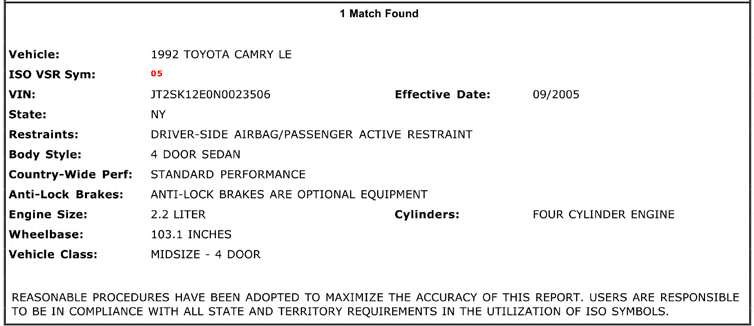
ISO Passport® Auto Symbol Reports provide complete information about the vehicles that your policyholders drive, enabling you to estimate underwriting risk correctly and calculate suitable premiums for automobile coverage.

The Auto Symbol Report provides the following information:
|
Vehicle |
The vehicle's make, model, and year. |
|
Vehicle Series Rating symbol. Vehicle Series Rating is an ISO program designed to match premiums to losses in an equitable manner. For each vehicle series (defined by such characteristics as make, model, body style, and wheelbase), ISO assigns a code called a rating symbol. ISO provides corresponding symbol factors that insurers may use in determining premiums for individual policies. A vehicle with a higher rating symbol will have a higher premium than a vehicle with a lower symbol, if all other rating variables are the same. |
|
|
VIN |
The vehicle identification number. |
|
State |
The state in which the vehicle is to be insured. |
|
Restraints |
Indicates the presence of vehicle restraints, such as automatic seat belts and airbags. |
|
Body Style |
Identifies the vehicle's design — for example, coupe, sedan, sports car, or utility vehicle. |
|
Country-Wide Perf |
Identifies the vehicle's level of performance — for example, low, standard, or high performance. |
|
Antilock Brakes |
Identifies the availability of antilock brakes. |
|
Engine Size |
The vehicle's engine size. |
|
Cylinders |
The number of cylinders in the vehicle's engine. |
|
Wheelbase |
Indicates the distances between the center of the front wheels and the center of the rear wheels. |
|
Four-Wheel Drive |
Indicates whether or not the vehicle has four-wheel drive. |
|
The weight of an empty vehicle when it is fully fueled and all fluid levels are high. |
|
|
Gross Weight |
The maximum weight of the vehicle when it includes cargo and/or passengers. |
|
Height |
The height of the vehicle. |
|
Horsepower |
The automobile engine's horsepower. |
|
The vehicle's class — for example, economy, compact, midsize, or large utility. |